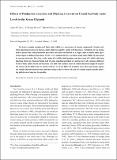| dc.contributor.author | Amos W. OKAL, P. Okinda OWUOR, David M. KAMAU, Lawrence O.A. MANG’URO | |
| dc.date.accessioned | 2020-07-28T11:40:47Z | |
| dc.date.available | 2020-07-28T11:40:47Z | |
| dc.date.issued | 2012-05-01 | |
| dc.identifier.issn | Online ISSN : 1881-3984 | |
| dc.identifier.issn | Print ISSN : 1344-6606 | |
| dc.identifier.issn | ISSN-L : 1344-6606 | |
| dc.identifier.uri | https://repository.maseno.ac.ke/handle/123456789/1631 | |
| dc.description.abstract | Tea leaves contain unsaturated fatty acids which are precursors of aroma compounds. Despite uniform plucking practices in Kenya, plain black tea quality varies with locations. Variations in tea aroma
and/or precursors with production area have not been established in a single cultivar under same agronomic input at different locations. Trials were conducted in five locations using clone BBK 35, harvested
at varying intervals. The fatty acids varied (P ≤ 0.05) with locations and increased (P ≤ 0.05) with long
plucking intervals, demonstrating leaf of same standard plucked at varying intervals contains different
levels of fatty acids even in one location. The different increase rates in various locations might be in part
the reason of the differences in aroma of black tea from different locations even when agronomic inputs
are similar. Results demonstrate that harvesting at shorter intervals and developing region-specific plucking policies may improve tea quality. | en_US |
| dc.publisher | J-STAGE | en_US |
| dc.subject | tea, Camellia sinensis, fatty acids, plucking interval, location of production | en_US |
| dc.title | Effects of Production Locations and Plucking Intervals on Clonal Tea Fatty Acids Levels in the Kenya Higlands | en_US |
| dc.type | Article | en_US |

